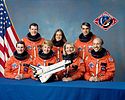STS-40
 | |
| Dane misji | |
| Indeks COSPAR | 1991-040A |
|---|---|
| Zaangażowani | |
| Oznaczenie kodowe | STS-40 |
| Pojazd | |
| Wahadłowiec | |
| Załoga | |
 | |
| Dowódca | |
| Start | |
| Miejsce startu | |
| Początek misji | 5 czerwca 1991 13:24:51 UTC |
| Orbita okołoziemska | |
| Apogeum | 296 km |
| Perygeum | 287 km |
| Okres orbitalny | 90,4 min |
| Inklinacja orbity | 39° |
| Lądowanie | |
| Miejsce lądowania | Edwards AFB, Pas startowy 22 |
| Lądowanie | 14 czerwca 1991 15:39:11 UTC |
| Czas trwania misji | 9 dni, 2 godz, 14 min, 20 s |
| Przebyta odległość | 6 083 223 km[1] |
| Liczba okrążeń Ziemi | 146[1] |
| Program lotów wahadłowców | |
STS-40 (ang. Space Transportation System) – jedenasta misja wahadłowca kosmicznego Columbia i czterdziesta pierwsza programu lotów wahadłowców. Pierwszy lot w ramach programu Spacelab Life Sciences (SLS-1)[2].
Załoga
- źródło[2]
- Bryan O’Connor (2)*, dowódca (CDR)
- Sidney Gutierrez (1), pilot (PLT)
- James Bagian (2), specjalista misji 1 (MS1)
- Tamara „Tammy” Jernigan (1), specjalista misji 2 (MS2)
- Margaret Rhea Seddon (2), specjalista misji 3 (MS3)
- Francis „Drew” Gaffney (1), specjalista ładunku 1 (PS1)
- Millie Hughes-Fulford (1), specjalista ładunku 2 (PS2)
- *Cyfry w nawiasie oznaczają liczbę lotów odbytych przez każdego z astronautów
Parametry misji
- źródło[1]
- Masa:
- startowa orbitera: 113578 kg
- lądującego orbitera: 102752 kg
- ładunku: 11767 kg
- Perygeum: 287 km
- Apogeum: 296 km
- Inklinacja: 39,0°
- Okres orbitalny: 90,4 min
Cel misji
Lot naukowy, wypełniony prowadzeniem eksperymentów medycznych i biologicznych na pokładzie laboratorium Spacelab SLS-1 (Space Life Sciences)[2]. Była to piąta misja laboratorium Spacelab[1]. Eksperymentom poddano ludzi, 30 gryzoni i tysiące małych meduz[1].
Zobacz też
- STS-58 – drugi lot w ramach SLS
- lista misji wahadłowców
- lista załogowych lotów kosmicznych
Przypisy
Linki zewnętrzne
- podsumowanie misji STS-40 na stronie NASA (ang.)
- Mark Wade: STS-40 (ang.). W: Encyclopedia Astronautica [on-line]. [dostęp 2017-07-25].
- Spaceflight mission report: STS-40 (ang.). W: Spacefacts [on-line]. [dostęp 2017-07-25].
Media użyte na tej stronie
The flag of Navassa Island is simply the United States flag. It does not have a "local" flag or "unofficial" flag; it is an uninhabited island. The version with a profile view was based on Flags of the World and as a fictional design has no status warranting a place on any Wiki. It was made up by a random person with no connection to the island, it has never flown on the island, and it has never received any sort of recognition or validation by any authority. The person quoted on that page has no authority to bestow a flag, "unofficial" or otherwise, on the island.
STS-40 Mission Insignia
The STS-40 crew portrait includes 7 astronauts. Pictured on the front row from left to right are F. Drew Gaffney, payload specialist 1; Milli-Hughes Fulford, payload specialist 2; M. Rhea Seddon, mission specialist 3; and James P. Bagian, mission specialist 1. Standing in the rear, left to right, are Bryan D. O'Connor, commander; Tamara E. Jernigan, mission specialist 2; and Sidney M. Gutierrez, pilot. Launched aboard the Space Shuttle Columbia on June 5, 1991 at 9:24; am (EDT), the STS-40 mission was the fifth dedicated Spacelab Mission, Spacelab Life Sciences-1 (SLS-1), and the first mission dedicated solely to life sciences.


